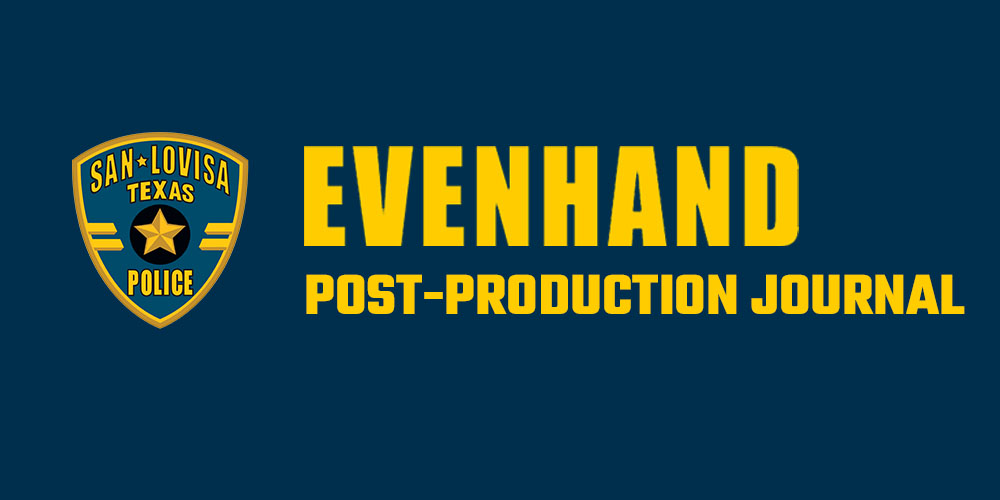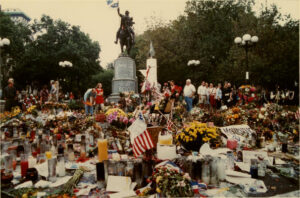
Union Square, New York City, September 2001 Copyright © 2004 Mary Louise Pierson
Tens of thousands of stunned, dust covered office workers–most in clinical shock–sure knew why they were getting across the Brooklyn Bridge as quickly as they could that September 11 morning. The second World Trade Center tower had just collapsed twenty minutes before turning the streets of lower Manhattan into something out of John Hershey’s Hiroshima. According to radio reports, as many as 6 other planes had been hijacked. No one had any idea what was next.
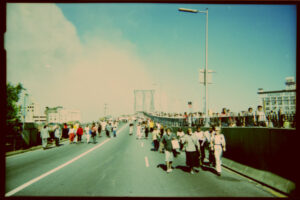
But I was at a loss to explain why I was “going the wrong way”, as someone shouted and still haven’t really figured it out six months down the road. The shock wave from the second crash had rattled my windows so violently I thought they might break. Within minutes I was upstairs on my Brooklyn rooftop watching in horror as the towers across the East River—towers that I had looked at every day for the 5 years I had lived there—burned from the mid-drift, then fell. Boiling smoke from the first collapse had blotted out everything in sight. The smoke had cleared just in time to let us see the second tower go. Its falling steel and shards of glass caught the glints from otherwise glorious late summer sun, as a low volcanic roar crossed the water.

On the bridge, there were people of every race, ethnicity and social class, but somehow everyone was wearing the same look of terror. Meanwhile the inbound lanes were filled with a wailing torrent of emergency vehicles–police cars, fire trucks and ambulances— setting off dust swirls as they raced to the scene. The closer I got to the other side, the darker and more smoky it got.
A neighbor had warned that someone on the radio had said something about poison gas. But as I got closer I just kept going, pulling my tee shirt up over my mouth so I could breathe. It was as if the smoking hole in the skyline was sucking me into it, almost involuntarily.
I had been a war correspondent for a few years in South Asia. Although I had thought I had outgrown the often-less than noble impulses that propelled me then, I realized I still felt what Sebastian Junger has called “an amoral sense of awe” in the face of destruction. But at another level, there was something else–something deeper, more reflective of my core identity, though I had resisted acknowledging that for years.

Memory kicking in as I passed Police Headquarters , I recalled the day my father had been promoted to Detective Captain in 1970. We had gone to dinner en very large Irish Catholic famille to celebrate in the city, but on the drive home had come across a violent car crash right by Yankee Stadium. After pulling over, my father jumped out of the car; he and I pulled the man at the wheel from his car shortly before it caught on fire. “A cop is never really off-duty, even a captain,” I roughly recall him explaining to me, my mother not exactly thrilled with the course of events. “I’m not allowed to pass by something like that.”
New York may be a big city, but for me, a member of a family with four generations of New York police detectives in it, it was basically a town like many others, and I was a townie. A force as strong as any I’d felt before to witness tragedy as a correspondent was making me want to change spots and help out, townie humanitarianism trumping the journo voyeur.
City Hall looked like a perverse Currier and Ives, the scene dusted with four inches of ash. But the side streets off Lower Broadway were mean, the sky blotted out by menacing tornado clouds, black at their center. A couple of loud “BA-BOOMS” shook the air. A police officer I asked said he thought they were burning cars exploding. I would later learn they were various ordinance in the arsenal the US Secret Service kept in their World Trade Center bunker.
As I stood dumbstruck across Broadway from the Woolworth Building, a weird manic guy in his late 20’s or early thirties emerged out of the cloud of ash and dust. Pushing some kind of cart loaded with bottles of drinking water, he looked for all the world like something out of Mad Max. He had office shoes and trousers and a button down shirt, and had pulled a red tee shirt over his face, completely obscuring it but for his outsized aviator glasses. I asked him where the Red Cross had set up its command center and where volunteers should report. Just pick up some water and hand it out, he replied handing me some water bottles, and a paper face mask. ”God Bless You sir, “ he shouted over his shoulder, disappearing into the mist again. “God Bless You.” *

Just after he disappeared into the clouds, another man, this one in late middle age, staggered from them, wheezing badly. He was wearing a smudgy brown suit, and carrying a preposterous, bulging brown leather briefcase. Grabbing him beneath the arms, I walked him up Broadway where an oxygen station had been set up. The man said he was a senior manager from the Federal Emergency Management Agency (FEMA). “I dove behind a truck, he explained, in shock. That’s the only reason I’m alive. There were people behind me, but I don’t think they made it. There was seven feet of debris on the street.”
After helping him into an ambulance, I lingered. Some of the cops regrouping in the area were completely covered in dust. Along with battered helmets, they were wearing the proverbial “thousand yard stare.” They had been first responders and had gotten hit hard when the buildings fell, officers right next to them buried in cascading concrete and steel. A few, like a kid who couldn’t have been more than 22, had been blinded by the debris and were having their dust-caked eyes washed out before going to the hospital.
A nurse and doctor in scrubs were waiting around and explained they going to a triage center that had been set up at the Staten Island Ferry. Since I had First Aid and CPR training from my days as an Urban Park Ranger just after college, they said they could put me to use.
Escorted by a Fire Department paramedic supervisor we headed to the Ferry. The side streets–Vesey, Liberty, John, Fulton–were dark, the air more noxious. As we double-timed it, the supervisor took a quick survey. “What skills do we have? Who can do what?” he asked. “ Who’s a doctor? Nurse? RN? PN? Paramedic. EMT?” First Aid and CPR, I volunteered, sheepishly.
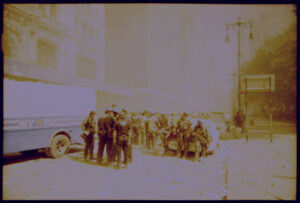
We passed the Federal Reserve Bank, home to a few billion dollars in US gold reserves. There, the smoke so thick we literally bumped into a phalanx of guards with snub-nosed assault weapons at the ready. The adrenaline level was very high all around.
Some on our crew ran ahead. Trying to practice “active detachment”, which used to work in landmine areas or sniper alleys in Sri Lanka and Burma, I tried to calm myself by focusing on small things, almost unconsciously. At one point I stooped to pick up a piece of paper, one of millions of pieces of paperwork that went flying when the towers fell. The irony of finding a doctors order for labs tests for someone involved in a Maritime Compensation insurance claim case was distracting, as was the crunch of debris beneath our feet.
At the ferry terminal, the Chief of the New York Fire Department’s Emergency Media Services gave a briefing. Ours would be a standard triage center, with three different zones: green for minor injuries, yellow for the next level and red for really serious cases. “There will be no freelancing,” the EMS commander made it clear. “If you don’t know something , ask. “
As we raced to assemble blood pressure cuffs–and blood plasma trolleys, a couple of thirsty firemen used their emergency crowbars to try to open a couple of soda machines standing against a wall. As they whaled away, they dented the machines but could not open them. Someone just brought down two of the worlds biggest buildings and somehow these soda machines were impregnable.
I was assigned to keep patients hydrated, to help wash out eyes and to keep track of names. “Got any scotch?, asked one shaky elderly man when I handed him a cup of water.
Almost all of the people we treated spoke of ducking or diving into doorways to avoid debris and choking dust. Most were not injured too seriously. People either got away from the towers or they got killed. But the screams of the few in the red zone were desperate. A middle aged woman wore a badge identifying her as a “Loss Prevention Officer” at American Express, whose headquarters had been severely damaged.
Around 12:30 PM, no one yet having an overview, I saw two EMT’s whispering to each other, not realizing I was in earshot.
“We lost a lot of guys,” one said out of the side of his mouth. “They set up the command center right at the base of the south tower and a lot of our guys got hit when the second plane went in.”
“How many we talking about. How many unaccounted for?” His colleague asked, blank faced.
“Don’t know,” the first one said, grimacing. “But we’re talking whole companies, whole squads. Rescue One. Ladder Three. Ladder Four. A whole bunch of chiefs.” he kept on going. “Some companies, they can’t find anyone. Nobody at all. “
Four EMT’s brought in a fire chief, his usually bright white uniform shirt soiled and blood-stained. An older man in his sixties, he had been found buried in some debris on the edges of the site. His face was bright red, and he looked on the edge of cardiac arrest. realizing this, , the medics who brought him in wheeled him back into an ambulance for a hospital. As they were doing so, I noticed a couple of men with blue jackets from the FBI/NYPD Joint Terrorism Task Force. They were scanning the scene, probably looking for colleagues with offices in the Towers or buddies or brothers on “the job” who might have been injured in responding.
Any numbers yet? I asked one of them wondering if anyone had any casualty estimates yet. He looked right through completely stone-faced and walked away. “No, no numbers yet,” shaking his head.
In a corner, talking to a clerical counselor, a Russian woman in her early twenties was hysterical. Her younger sister, a very recent immigrant who had been working in the south tower was missing. “I just feel like going there and digging, digging, digging with my bare hands to find her,” the Russian woman sobbed.
The girl explained that her sister was habitually late for work and that her boss had put her on probation. Maybe she was late today, I comforted. The first plane had hit shortly before nine. They had stopped letting people inside both towers at that point. If she was late–even if she was on time–she might still be alive. The Russian girl turned back to the pay phones, calling around to see if any of their friends had heard from her sister.
Hardly anyone came in after 2:30. I decided to walk to another triage center, where I would make inquiries about the Russian woman’s younger sister. It was actually quite easy to get around. Once inside the police perimeter, and with an official looking mask and blue surgical gloves, I looked like part of the scene. When cops did inquire about what I was doing there, they steered me west. Pretty soon I was moving up the very bottom of Broadway, passing the Merril Lynch Bull, which looked odd in the desolation and covered in dust.
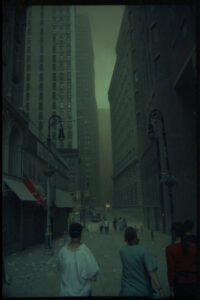
Pretty soon I was deep inside Broadway’s “Canyon of Heros”. I had once seen a ticker tape parade there honoring Norman Schwarzkopf and Colin Powell after the Gulf War. But the scene had been transformed to look more like an image from the losing side of that war–the infamous “Turkey Shoot” when US warplanes strafed retreating Iraqi armored columns. Everything around me was destroyed. It was a pumicey hell, with millions of pieces of loose paperwork from the towers incongruously blowing through it.

Overhead, a few skyscrapers were on fire, with burning debris sailing fiendishly through the air. The buildings that were not on fire wore ugly gashes, their windows blown out. One the buildings on fire was #90 West Street, an old architectural grandee. I remembered that when it was dedicated in 1907, my grandmother, who was 12 at the time, had walked across the Brooklyn Bridge with her sisters and friends, for the ceremony. It was the first time they had been allowed to go to Manhattan by themselves.
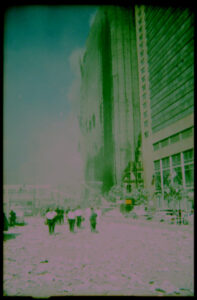
At street level, the scene was equally apocalyptic. Ambulances, fire trucks and police cars were scattered around, many crushed, without glass. A few of the fire trucks had their noses stuck in the debris with their backsides raised in the air, like a seesaw. A few of the overturned cars on the side were still burning, flames licking out of windshields and passenger windows. The sirens on some of the cars were still squealing, though in that weird sonic environment, the smoke muffled everything. What would have been piercing barely made an impression, as if it all was happening underwater.
Without the towers as markers I was feeling lost. The I looked up and saw a familiar pedestrian overpass that I had used many times to go into the Wall Street Journal. It only dawned on me then. I was on the corner of Liberty Street and West Street: right at Ground Zero itself. The smoke was so thick, and the scene so surreal I didn’t even notice.
There was only about 100 feet visibility. Every once and a while though the wind would shift. Then, like an iceberg breaking through the mist, the towers’ jagged facade would emerge. The break in the smoke would also allow a glimpse here and there of antlike rescue workers working on the rubble–still flaming in some spots. Some of the rescuers were roped together like men on the moon might be and were carrying powerful searchlights. Still, there was no sense of the scale of destruction, the acres of devastation we would all see in coming days. Just as eerily, the wind would shift again, the the white-out would resume. The mood was bizarre, a weird intermingling of creational energies those those of utter carnage. It was like being on top of a Himalayan mountain, the slag still cooling and shifting from volcanic forces below.
Shell-shocked firemen were sitting on piles of wreckage, legs spread apart like uncomprehending five year olds, staring into the dust and glare. Others had taken refuge in a darkened grocery store, sitting dazed and hollow-eyed in the dark. One exhausted fire captain with a silver crew cut said they had found a few guys from Rescue One, and had heard they’d come across some guys from Ladder Two. Trying to match the good news, I told him about a fire chief who’d been pulled from the rubble and treated at the triage unit, though I did not mention he looked on the lip of cardiac arrest.
The edge of the scene was just as surreal, still bearing scars of the brutal force that had moved through. Rescue vehicles churned up muck as if it were snow in a blizzard. Huge padlocks had been placed on expensive, now evacuated, co-op buildings–some with palm trees stenciled on their shredded awnings–to secure them from looters. And a klatch of baby carriages was still chained to trees in from of a Starbucks, with a lone pram blown into the branches of a nearby sapling.
Trying to get to the other triage center, I encountered a young priest, sitting on a park bench, exhausted. He held a Last Rites kit in his hands and stared across the Hudson River into New Jersey.
“You all right, father?” I asked. “I’ll be OK. I just needed a break,” he responded in a very low voice. “We lost a lot of people in there.” Around the World Financial Center marina, firemen were sprawling on outdoor chairs at tables where bankers and brokers usually sipped cocktails or checked out boats.
Unable to get up to the other triage center, I made my way back to Ground Zero, handing out water bottles from a stash delivered by the same motley character who had given me God’s blessing earlier in the day. Even when he disappeared into the mists again I could hear him, the wheels of his cart rolling along and his voice booming out hearty “God Bless You’s”.
Ultimately unable to get up to the other triage center, I made my way back to Ground Zero. More of the jagged facade of the collapsed towers was visible from this new angle, as was the burning hulk of #7 World Trade Center, flames roaring sideways out of that 50 storey building before curling toward the blackened sky. The fire here now officially out of control, and fire supervisors were trying to clear the area before the now-inevitable collapse. “ Get out of Here! Go Now!” one ordered. But some of the fireman hesitated. They were worried that some of their comrades were trapped inside. A chief reassured them. “We’ve got all of our guys in that building accounted,” for he explained. “Everyone who went into #7 is out now.”
Drifting over to a staging area along the West Side Drive, I found myself in a sea of firemen and rescue cops. Some who had been there all day were cooling off, their overalls rolled down. A few of the latter were wearing The Stare, some of them having seen people throw themselves from the 105th floor to escape the flames, their bodies splattering two storeys high like water balloons.
Others were readying to go in, keeping the anxiety and stress at bay with jokes and verbal jabs, the air thick with New York accents. Although I did not know it at the time, among these rescuers were several cousins, still on the Job and my brother, a retired sergeant who had gone in too when he’d seen the towers go. He would not go home for three nights, joining the bucket and shovel brigade trying to dig survivors out.
Always feeling a bit ambivalent about my townie side, in the past these kind of guys made me often feel like a groom might felt at a wedding, steering his bride from the table of loud uncles she had not yet met. But that day I felt nothing but pride both to be among them and to be one of them. I also felt curiosity about the workings on fate: What if I had become a cop? If I was hard working and lucky, I’d be a captain or an inspector by now, with a command in lower Manhattan, if my generational hooks did the trick. I might be standing there formulating orders — or I might be buried somewhere down the street, along with the first responders under my command.
At one point, a half dozen FBI agents in blue nylon windbreakers walked through the scene, the crowd hushing. “And the feds had no clue?,” one sarcastic firemen muttered loud enough to be heard. “Give me a break.”
A few minutes later, just on the far lip of the restricted zone, a young cop stood looking into the chaos. “I’m not supposed to be down here,” he explained, admitting he had left his assigned post further uptown. His dusty face was creased with sweat and maybe tears, and he stabbed his cell phone for what must have been the thousandth time that day. “But my brother’s a firemen and my mother just called me and said he might still be in there.”
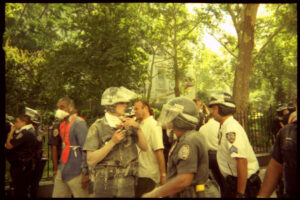
On my way home, the crowd of spectators on the other side of the barricades in Tribeca seemed right on the edge between anarchy and order. In a bar, people were cringing and yelping as the news anchor announced that the third major building of the day was about to come down. Outside, it was like watching a science fiction film as the building collapsed and its roaring cloud of smoke and dust chased panicked people up the street. For some though there was significant denial. At the Tribeca Grand Hotel, a fashion model/doorman was trying to calm some out-of-town tourists. “Everything will be back to normal in a couple of days, don’t worry.”
With the Brooklyn Bridge shut down now, and no trains running, I had to walk across the Manhattan Bridge. My feet were aching from about 10 miles of uneven footing, with irritants of all kind working their way into the blisters.
On the bridge at sunset, high above the city, I recalled the 1976 Bicentennial. Friends and I had gone downtown to watch the Tall Ships and the fireworks that followed in Battery Park. We’d stayed out all night, closing the adventure with a beer-soaked conga line around lower Manhattan, to the tune of “When the Saints Go Marching In.” It had been one of the best days of my then-young life, filled with a spirit of profound unity, good cheer, and democracy with a small “d” among people of every race, color and creed.
The sky that evening was similar: a beautiful aquamarine streaked with red and purple. But now the skyline was gouged, in a way that was almost human. It was as if someone had had his nose ripped from his face or teeth smashed from his mouth. A blood-orange sun sank into a black cloud of soot.
An African American police officer standing guard on the Brooklyn side of the bridge had disturbing news. Gangs of roaming toughs had started attacking some Arab-owned stores up on Atlantic Avenue, the officer reported. “But what can you expect?” he insisted. “People want something done.”
Later that night I looked into the mirror and saw a guy standing there with the same thousand yard stare I’d seen all that day long on the cops and firemen and medics I’d been with. I would have that expression on my face for more than a week.
“You look like you’ve been in a war zone,” one of my neighbors said.
“I guess I have”, I answered, my eyes still red-rimmed and stinging.
Copyright © 2004 William McGowan
All photographs Copyright © 2004 William McGowan unless otherwise noted
Reproduced with permission
* While I have not confirmed it yet, I have every reason to believe that this was Cosmo. Lovisa called me on the morning of September 11th, extremely upset because Cosmo had gone down to the World Trade Center to help. The buildings had just come down and she had been unable to reach him. – Joseph Pierson
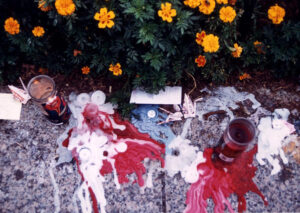
Joseph Pierson


